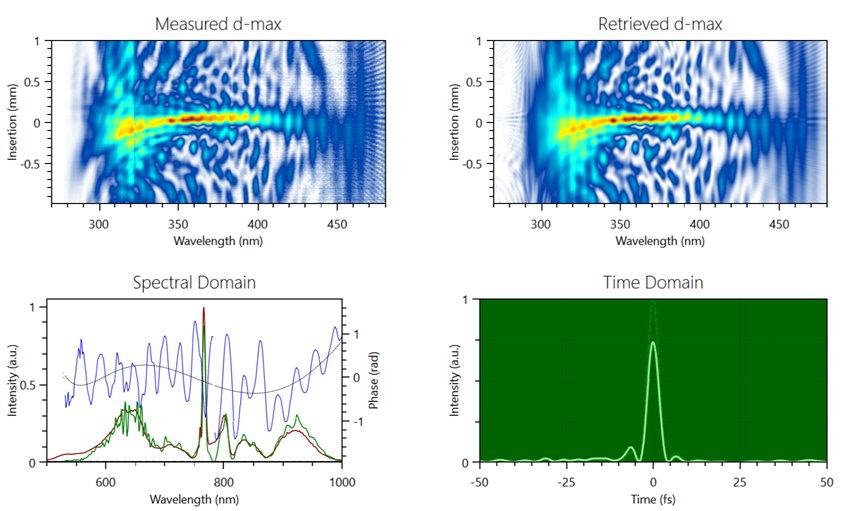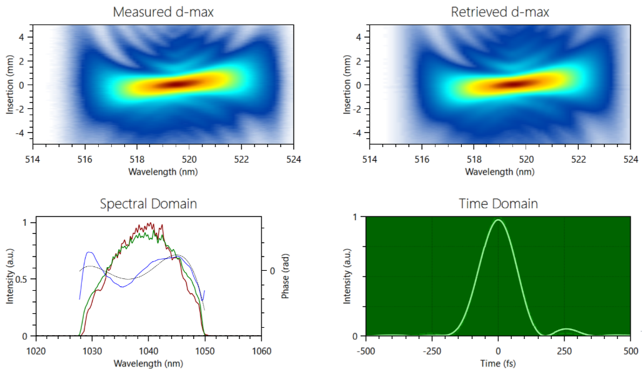THE HIGH-PERFORMANCE TOOL FOR MASTERING YOUR HOLLOW-FIBER OR MULTIPASS CELL POST-COMPRESSOR DOWN TO FEW-CYCLE PULSES
The d-max is the system of choice for fast and accurate measurement of even the most demanding ultrafast pulses, down to ultra-broadband spectra and few-cycle durations. Its compact, standalone design supports a wide range of ultrashort pulse sources, including broadband laser oscillators, amplifiers, OPAs, and hollow-core fiber and multipass cell post-compressors. The d-max’s compact footprint packs a dispersion-calibrated system that measures your pulses exactly as they are, without ambiguities. Beam coupling takes less than a minute, and a full measurement completes in under 10 seconds. The intuitive d-max trace gives instant visual feedback via the unique Virtual LogbookTM interface, while its proprietary algorithm ensures fast, accurate pulse reconstruction.
8 fs, Multi-Pass Cell compressor : d-max SWIR (700 nm – 1400 nm)

(top) Measured and retrieved d-max traces; (bottom left) Measured spectrum (red), retrieved spectrum (green), retrieved spectral phase (blue), 4th order polynomial fit of spectral phase (black); (bottom right) Retrieved temporal profile showing 8 fs pulses (light green), FTL pulse (dashed green).
8 fs, Ti:Sapphire Oscillator : d-max R (600 nm – 1100 nm)

(top) Measured and retrieved d-max traces; (bottom left) Measured spectrum (red), retrieved spectrum (green), retrieved spectral phase (blue), 4th order polynomial fit of spectral phase (black); (bottom right) Retrieved temporal profile showing 8 fs pulses (light green), FTL pulse (dashed green).
3.7 fs, Hollow Core Fiber : d-max B (500 nm – 1000 nm)

(top) Measured and retrieved d-max traces; (bottom left) Measured spectrum (red), retrieved spectrum (green), retrieved spectral phase (blue), 4th order polynomial fit of spectral phase (black); (bottom right) Retrieved temporal profile showing 3.7 fs pulses (light green), FTL pulse (dashed green).
162 fs, Pharos Laser : d-max XR, Central λ = 1040 nm

(top) Measured and retrieved d-max traces; (bottom left) Measured spectrum (red), retrieved spectrum (green), retrieved spectral phase (blue), 4th order polynomial fit of spectral phase (black); (bottom right) Retrieved temporal profile showing 161.8 fs pulses (light green), FTL pulse (dashed green).
Technical Specifications
| d-max B | d-max R | d-max SWIR | d-max XR | |
| Optimized for | Hollow core fiber | Ti:Sapphire oscillator, OPCPA | Multi-Pass Cell compressor, OPCPA | Ti:Sapphire or Yb:fiber Amplifier, OPCPA |
| Wavelength range | 500 – 1000 nm | 600 – 1100 nm | 700 – 1400 nm | Central λ : select within 500-1400 nm |
| Pulse duration (FTL)(a) | 4 fs to 50fs | 7 fs to 50 fs | 7 fs to 50fs | 40 fs to 200 fs |
| Chirp range | ±3500 fs2 | ±3500 fs2 | ±7000 fs2 | >300 000 fs2 |
| Repetition rate | 1 kHz and above(b) | |||
| Input polarisation | Linear | |||
| Maximum input aperture | 5 mm | |||
| Required input energy | >0.5 nJ @ 80 MHz <300 nJ @ 1 kHz |
|||
| Dimensions (WxLxH) | 250 x 200 x 100 mm | |||
(a) FTL = Fourier Transform Limit. The temporal duration can be much longer if the pulse is chirped (within the chirp range of the model)
(b) Lower repetition rates possible with external sync option
* Vacuum compatible systems available on request
Talk to us for different wavelength range, chirp range, input aperture, and other












